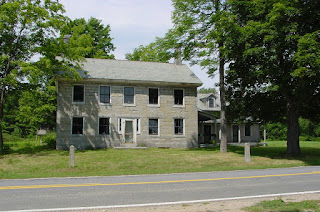 | ||
| Willsboro Point with Ligonier Point Credit: Google Earth |
Sometimes destiny and fate land one in the most unexpected places, places that some day will offer up untold treasures and opportunities as yet unknown. This is just what happened one day in 1998 when my husband, Bruce, first introduced me to Willsboro, New York, a very small, rural town on the western shore of Lake Champlain. Our town is packed full of history, some of which was yet to be unearthed as we found out in the years ahead. We drove north onto Willsboro Point and soon turned west onto Ligonier Point, a thumb of land stretching out into the lake. We followed a quiet country lane lined with stately 150-year-old sugar maple trees that arched their gnarled limbs overhead and thus my story begins.
For almost a hundred years the still extant 19th century Clark structures on Ligonier Point were only used seasonally, and many of the articles and artifacts that were within them remained undiscovered and untended. Remnants of the past were hidden in nooks and crannies, beneath floors, in attics and cellars, tucked away in old steamer trunks, and even behind books of a more contemporary nature. All manner of memorabilia, including an unused coffin, lay jumbled together in heaps on the bare earth floor of an old icehouse that had slowly deteriorated until there was nothing left but a shell that sat ready to fall to the earth at any moment. Each object, so long hidden from the outside world, was silently waiting to be awakened from its century-long slumber.
 |
| Scragwood Today Credit: Philip Hall |
We spent weekends and vacations salvaging and hastily storing everything that we could until finally in 2001 we left city and professional lives behind and took up permanent residency on Ligonier Point. At last we had the opportunity to begin opening the seemingly endless piles of boxes whose contents we had so hastily saved. Now began the arduous process of sorting and conserving that took until 2015. The doors to Scragwood and Old Elm, the Clark’s mid 19th century houses, and the numerous surviving outbuildings that supported the family endeavors as farmers, quarrymen and shipbuilders were flung open once again to let in air and life.
 |
| Old Elm Today Photo by Philip Hall |
As we worked, an abundance of questions kept bubbling to the surface. We found answers to some but certainly not all. Who were these Clarks who lived and worked on the land, on the lake and in those old buildings? What sorts of endeavors did they engage in? What were their daily lives like? Were they educated? Were they religious? Did they participate in local affairs? How were they viewed within their community? Did they ever travel beyond the shores of Lake Champlain? What did they really contribute that was truly lasting and meaningful? Were they participants in the making of history? The list of questions went on and on. We don’t pretend to have all of the answers yet - and maybe we never will – but we do have an ever-increasing understanding of the Clarks and the “world” in which they lived.
The story I tell begins wrapped in the misty folds of mystery and unknowns and then gathers momentum and clarity as it moves forward. There are some blanks that may never be filled in completely and pieces that will remain a bit ragged around the edges like a newly quarried bit of stone. We begin with George Clark, a young farmer in Canaan, Connecticut who sought a better life in a fledgling village on the western shores of Lake Champlain. Early records of Willsboro, New York and the Clark family are a bit scant in places, and so for the period from 1802 to 1850 there will be a mixture of fact and fiction but I have used primary sources wherever they are available. By 1850 the amount of raw material at my fingertips expands exponentially and the tale I have to tell springs from the 51,000 paper materials in the Clark Collection that we have amassed over the years.
 |
| The Clark Family Preparing to Leave Scragwood for Church Credit: Clark Collection |
With excitement and, yes, even some trepidation, after almost 18 years of discovery, caretaking and research I can finally share the story that lies within me. I invite you to come with me on my journey, to rejoice with the Clarks in the happy times, to suffer along with those whose lives were grim and short, to be inspired by the will and fortitude of these rugged people, to understand what kept them alive and functioning through thick and thin, to feel what they felt, to experience what they experienced, and to follow them through their daily lives. Whether you are a historian, researcher, or someone who is just plain interested in history and the people who created it, I hope that you will join me as my story unfolds in the coming weeks, months and, maybe even years.
Wonderful story. Can't wait for the upcoming episodes
ReplyDelete